Last week I shared a memorable photograph of a pair of Red-necked Grebes calling in unison on the water, having reversed their course to turn in my direction to display while illuminated in beautiful late morning sunlight (the second photo in last week’s Bird Photography feature). I refer back to that photograph to begin this week’s article, because after the grebes swam out of photo range I took a deep breath, and after taking an initial look at the photos on the LCD screen on the back of my camera, I was excited to see them later on my computer screen – full-sized.
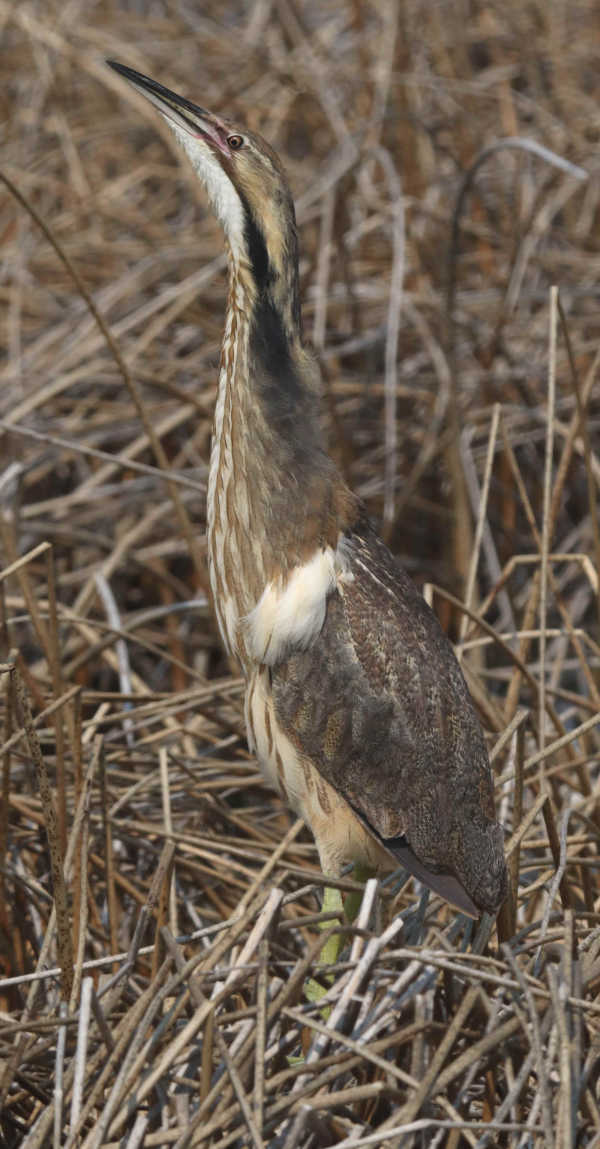
As it stood high in the midst of a tangle of bulrushes, the American Bittern’s extended white shoulder plumes indicated it had displaying in mind, a clue to continue to watch for potential photo action (270mm zoom lens, f-10 aperture, 1/2500 shutter speed, 800 ISO).
|
I started my car and pulled forward to turn left, when right there was the first of spring American Bittern – in a pre-display mode. Although it was standing tall in a bed of winter-dried bulrushes on the west edge of Herb’s Lake, it had its tell-tale white plumes showing just above the apex of it folded wings. The white plumes were an obvious clue to me that this tall male bittern might be displaying, as were the extended longer black feathers toward the bottom of the black vertical strip that extended from the head down the neck. I took a couple initial vertical photographs to fit the whole bittern into the frame, then looked for a female, a focus of the male’s elevated behavior. But no other wading birds were in sight among the tangle of bulrushes, not to say one wasn’t hiding or out of sight at that point.
Even so, after a couple minutes of standing tall while surveying its surroundings, the male American Bittern retracted its neck and bent low as the extended white shoulder plumes caught the breeze. After hesitating some moments, the bittern began stalking across the top of the tangle of dried bulrushes, extending its long neck and breast feathers more, which gave it more girth as it took longer strides forward and into a taller tangle of bulrushes.
I drove 30 feet forward in my “mobile blind” to keep up with the action, and stopped just as the bittern was emerging from taller vegetation. With its plumage in display mode, it advanced in a crouched position, stretching its legs forward and providing what was the signature image of this photo series.
From there the American Bittern stepped into an open area where the vegetation was packed down, and that’s where it went into full display, lowering its head and bill, raising its short tail vertically, then rising up again in full display. Although there was very little sound to go with the impressive behavioral display, perhaps calling would be more prevalent when a female was in sight. Clearly hoping to catch the attention of a female, hormones are a tricky thing for male birds; perhaps he was practicing, or laying claim to a territory. In the moment, the bittern sure provided an exciting, fast-paced photo session!
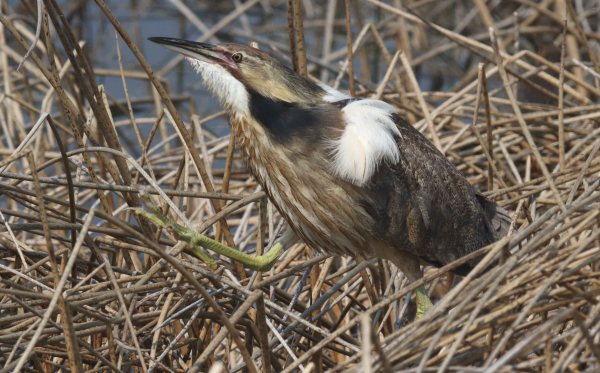
Tech Insights
Essentially, the technical settings for the photographs I was taking of the American Bittern the same as the series of photos I took of the displaying Red-necked Grebes moments before. I already had my camera settings dialed in to work well for the grebes, and the settings were fine for the bittern photos too. Essentially, the settings you see listed under each photograph have been pretty standard for birds I have been encountering in the field, among vegetation or in open water.
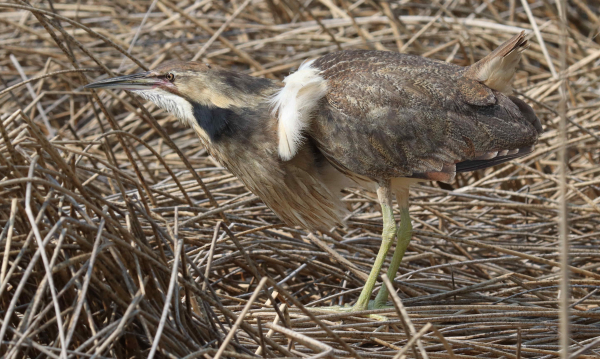
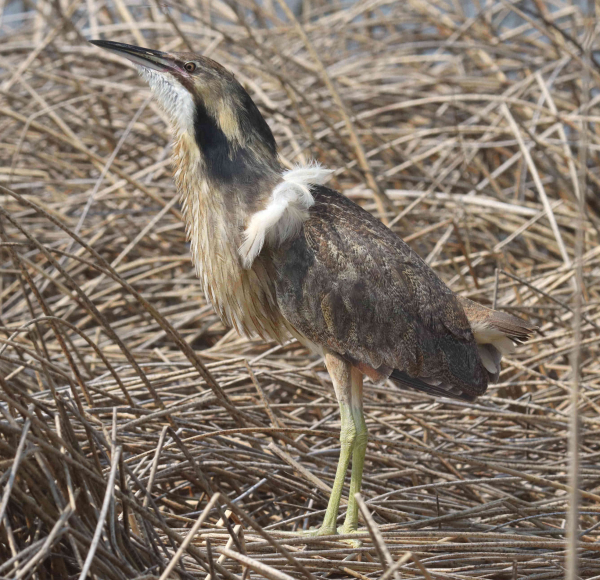
I always use the Av (aperture priority) setting so I can set the aperture I prefer under given photo conditions. In this case I had my aperture set at f-10 to have a fairly broad area in sharp focus. By using the Av setting, and dialing in the aperture, the camera provides the corresponding shutter speed. Using this technique is strongly recommended over using an automatic setting or even a programed setting. The aperture priority (Av) technique is a practice I strongly suggest to bird photographers – actually, any photographers.
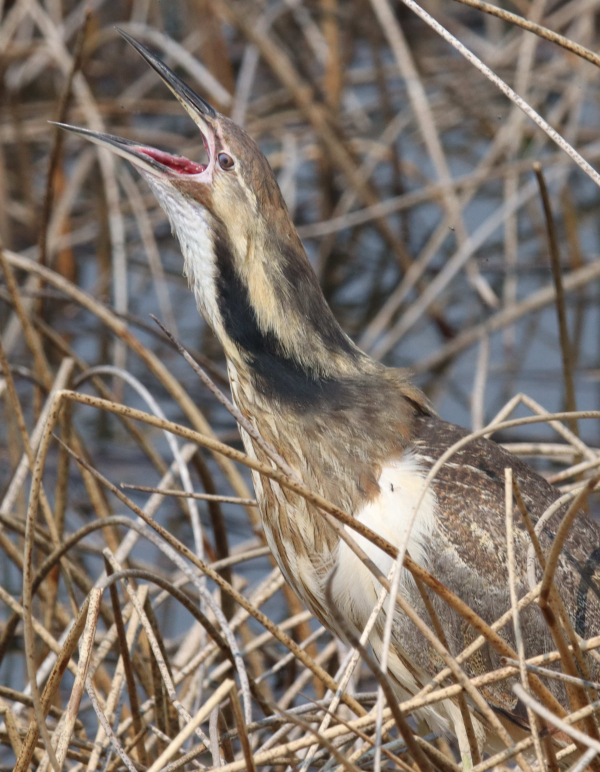
Although this dramatic image looks like the bittern could be making a loud trumpeting call, it was merely stretching its gape without making a sound, or it may have some visual behavioral significance (350mm zoom lens, f-10 aperture, 1/1600 shutter speed, 800 ISO).
|
Throughout this American Bittern photo session, I used the versatility of my zoom lens to zoom in and out as my position in relation to the active bird changed, and as the bittern crouched, stood tall, and stalked through plants. The zooming option provided the opportunity do a level of in-camera composition that provided some effective ‘cropping’ as I zeroed in on the bittern. Zooming also added to the fun and excitement during the fluid period of photo action.
Since that eventful Sunday morning (May 12th), spring migration has escalated, as have my photo opportunities on sunny days, or days with periods of sunshine. It’s a remarkable time of the year when nature, climate, weather, and birds set the stage for everyone with a camera to take birding to the next level, while taking photography to a higher level personally too. More birds provide chances to practice your photo techniques and elevate your reaction time, while fine tuning your tech settings – all depending on where you are photographing and what birds you are focusing on. Good Luck and Enjoy this exciting spring birding season!
Article and photographs by Paul Konrad
Share your bird photos and birding experiences at editorstbw2@gmail.com